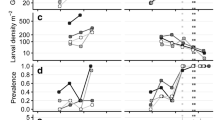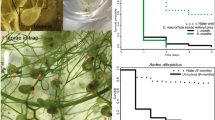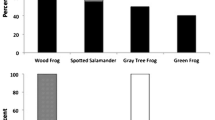Summary.
The rate of loss of activity of invertebrate iridescent virus 6 (IIV-6, family Iridoviridae) was determined in two artificial aquatic habitats in southern Mexico, using a sensitive insect bioassay technique. IIV-6 placed in trays of water in direct sunlight suffered rapid loss of activity (99.99% reduction) over a period of 36 h, during which water temperatures fluctuated between 24 and 41 °C. No significant deactivation occurred during the hours of darkness. In contrast, IIV-6 placed in trays of water in the shade lost 97% of original activity over a 60 h period, during which water temperatures fluctuated from 24 to 31 °C. Longitudinal analysis involving mixed effects models of time (shade) and cumulative exposure to ultraviolet radiation (sunlight) indicated that the rate of deactivation was best described by third order polynomial equations in both cases. We conclude that the likelihood of transmission of IIVs in aquatic habitats will be mediated by the intensity of UV radiation and water temperature.
Similar content being viewed by others
References
MM Caldwell CL Ballaré JF Bornman SD Flint LO Björn AH Teramura G Kulandaivelu M Tevini (2003) ArticleTitleTerrestrial ecosystems, increased solar ultraviolet radiation and interactions with other climatic change factors. Photochem Photobiol Sci 2 29–38
Chinchar VG, Essbauer S, He JG, Hyatt A, Miyazaki T, Seligy V, Williams T (2005) Iridoviridae. In: Fauquet CM, Mayo MA, Maniloff J, Desselberger U, Ball LA (eds), Virus taxonomy: Eighth Report of the International Committee on the Taxonomy of Viruses. Elsevier, London, pp. 163–175
M Constantino P Christian CF Marina T Williams (2001) ArticleTitleA comparison of techniques for detecting invertebrate iridescent virus 6. J Virol Methods 98 109–118
MF Day EH Mercer (1964) ArticleTitleProperties of an iridescent virus from the beetle Sericesthis pruinosa. Aust J Biol Sci 17 892–902
NJ Jakob K Muller U Bahr G Darai (2001) ArticleTitleAnalysis of the first complete DNA sequence of an invertebrate iridovirus: coding strategy of the genome of Chilo iridescent virus. Virology 286 182–196
JR Linley HT Nielsen (1968) ArticleTitleTransmission of a mosquito iridescent virus in Aedes taeniorhynchus. I. Laboratory experiments. J Invertebr Pathol 12 7–16
M López JC Rojas R Vandame T Williams (2002) ArticleTitleParasitoid-mediated transmission of an iridescent virus. J Invertebr Pathol 80 160–170
CF Marina JM Feliciano J Valle T Williams (2000) ArticleTitleEffect of temperature, pH, ion concentration and chloroform treatment on the stability of invertebrate iridescent virus 6. J Invertebr Pathol 75 91–94
Marina CF, Fernández-Salas I, Ibarra JE, Arredondo-Jiménez JI, Valle J, Williams T (2005) Transmission dynamics of an iridescent virus in an experimental mosquito population: the role of host density. Ecol Entomol (in press)
CF Marina JE Ibarra JI Arredondo-Jiménez I Fernández-Salas P Liedo T Williams (2003) ArticleTitleAdverse effects of covert iridovirus infection on life history and demographic parameters of Aedes aegypti. Entomol Exp Appl 106 53–61
CF Marina JE Ibarra JI Arredondo-Jiménez I Fernández-Salas J Valle T Williams (2003) ArticleTitleSublethal iridovirus disease of the mosquito Aedes aegypti is due to viral replication not cytotoxicity. Med Vet Entomol 17 187–194
I Miocevic J Smith L Owens R Speare (1993) ArticleTitleUltraviolet sterilisation of model viruses important to finfish aquaculture in Australia. Aust Vet J 70 25–27
BA Mullens RK Velten BA Federici (1999) ArticleTitleIridescent virus infection in Culicoides variipennis sonorensis and interactions with the mermithid parasite Heleidomermis magnapapula. J Invertebr Pathol 73 231–233
RT Noble JA Fuhrman (1997) ArticleTitleVirus decay and its causes in coastal waters. Appl Environ Microbiol 63 77–83
M Ohba K Aizawa (1982) ArticleTitleMammalian toxicity of an insect iridovirus. Acta Virol 26 165–168
DT Petrik I Iseli BA Montelone RJ Van Etten JL Clem (2003) ArticleTitleImproving baculovirus resistance to UV inactivation: increased virulence resulting from expression of a DNA repair enzyme. J Invertebr Pathol 82 50–56
Pinheiro JC, Bates DM (2000) Mixed-Effects Models in S and S-PLUS. Springer, Heidelberg, Germany
LJ Reed H Muench (1938) ArticleTitleA simple method of estimating fifty percent endpoints. Am J Hyg 27 493–497
A Reyes P Christian J Valle T Williams (2004) ArticleTitlePersistence of invertebrate iridescent virus 6 in soil. BioContr 49 433–440
G Ricou (1975) ArticleTitleProduction de Tipula paludosa Meig. en prarie en function de l’humiditié du sol. Rev Ecol Biol Sol 12 69–89
M Shapiro J Domek (2002) ArticleTitleRelative effects of ultraviolet and visible light on the activities of corn earworm and beet armyworm (Lepidoptera: Noctuidae) nucleopolyhedroviruses. J Econ Entomol 95 261–268
Williams T (1998) Invertebrate iridescent viruses. In: Miller LK, Ball LA (eds), The Insect Viruses. Plenum Press, New York, pp. 31–68
Williams T, Barbosa-Solomieu V, Chinchar VG (2005) A decade of advances in iridovirus research. Adv Virus Res (in press)
SW Wilhelm WH Jeffrey AL Dean J Meador JD Pakulski DL Mitchell (2003) ArticleTitleUV radiation induced DNA damage in marine viruses along a latitudinal gradient in the southeastern Pacific Ocean. Aquat Microb Ecol 31 1–8
Author information
Authors and Affiliations
Rights and permissions
About this article
Cite this article
Hernández, A., Marina, C., Valle, J. et al. Persistence of invertebrate iridescent virus 6 in tropical artificial aquatic environments. Arch Virol 150, 2357–2363 (2005). https://doi.org/10.1007/s00705-005-0584-z
Received:
Accepted:
Published:
Issue Date:
DOI: https://doi.org/10.1007/s00705-005-0584-z




